
Honest, paywall-free news is rare. Please support our boldly independent journalism with a donation of any size.
If you are concerned about the climate, you should be paying attention to what is happening in southeast Montana.
Part of keeping the global temperature rise as low as we can is keeping Montana coal in the ground.
To avoid catastrophic climate change, a recent study in the journal Nature found that 92 percent of coal reserves in the United States must stay in the ground to keep global temperature rise under 2 degrees Celsius. Montana has the largest amount of recoverable coal in the United States, close to 120 billion tons – almost one-quarter of known US reserves.
Arch Coal, a major US coal mining and processing company, has been pushing hard to gain access to Montana’s coal reserves since 2010.
“Montana could be the energy capital of the United States if the state government and the state’s community desire that to happen,” Arch Coal CEO Steven Leer told the Billings Gazette in 2010 after his company leased 1.5 billion tons of coal in the Otter Creek Valley in southeast Montana.
To this day, however, no permits have been issued for a coal mine in Otter Creek.
The mining project does not suffer from a lack of support from Montana’s politicians or from a regulatory environment unfriendly to their ambitions. What they suffer from is a severe lack of community support. There is a dedicated community of people in southeast Montana who fiercely love their land and have organized quietly and resolutely, keeping billions of tons of coal in the ground. Their repeated victories in bringing ranchers, Northern Cheyenne tribal members, Amish farmers and others together to fight the coal mines constitute one of the most inspiring – and most overlooked – stories of climate change activism in this decade.
How the Struggle Began
On January 17, 2013, a winter storm blew through southeast Montana. The wind was bitterly cold and roads were treacherous but the people came anyway. They braved the dark, icy highways and drove to the Northern Cheyenne tribal chambers in the small community of Lame Deer, Montana, to defend their homelands from the largest proposed coal mine in the country.
That night the Montana Department of Environmental Quality, the permitting agency, held a public hearing about the proposed Otter Creek mine. In 2010, the Otter Creek coal tracts were leased to Arch Coal by the state of Montana and Great Northern Properties. The Otter Creek tracts hold over 1.5 billion tons of coal and lie right next to the Northern Cheyenne Reservation in the heart of the northern Powder River Basin. The proposed mine and its companion rail line, the Tongue River Railroad, are the anchor projects the coal industry needs to access billions of additional tons of Montana coal.
That cold night in January, over 200 Northern Cheyenne tribal members gathered around a fire outside the tribal building, listening to the drums, wearing red and holding signs that said “Save Otter Creek” and “We love our homelands.” Local white ranchers from off reservation wore red scarfs and mingled in the crowd. No one went inside.
At 6 pm sharp, a representative from the state of Montana walked out of the building and asked to speak to someone. Uncertain of whom to address, she said – to no one in particular – if people didn’t come in, the state of Montana would end the hearing. The drums continued, but looks were exchanged, a nod was given and people began filing into the council chambers. Those who could not fit into the room spilled out into the hallway.
“We want the quiet, we want the peace, we want the clean air, we want the clean water and we’re not going to give it up without a fight.”
Those in attendance knew that the state planned on hosting an open house-style hearing in which the public was required to go to informational booths and then privately give testimony to a court reporter. Tom Mexican Cheyenne, a Northern Cheyenne tribal member, carried a portable PA system with him. With the support of the gathered crowd, Tom told the Department of Environmental Quality and Arch Coal representatives that they were guests of the Northern Cheyenne people and in Cheyenne country, people talk to people, not to recording devices. He told the state bureaucrats they were welcome to leave, but the people were going to stay and talk about the mine. They stayed.
Throughout the night testimony was punctuated by the sound of drums outside the building.
Lucas King, a Northern Cheyenne tribal member offered this testimony:
We are telling you we don’t want this. We all know how it goes, you guys move in, one side benefits and the other side doesn’t. And that’s how things are done in America. But this is Cheyenne country, it has been for a long time, longer than any dollar has ever lasted. And I know you guys, I don’t expect you to understand us, you don’t, and I’m not saying I understand you but I know you understand the word no. And in our language we say hová’åháne. Go back and tell who ever you have to, we don’t want this, it’s not for us.
The hearing was scheduled to last for two hours, but it ended up lasting for over four as dozens of citizens testified against the mine. At the very end, rancher Brad Sauer stood and said, “I want to say to my neighbors, the Northern Cheyennes, thank you for showing me what free speech looks like and sounds like.”
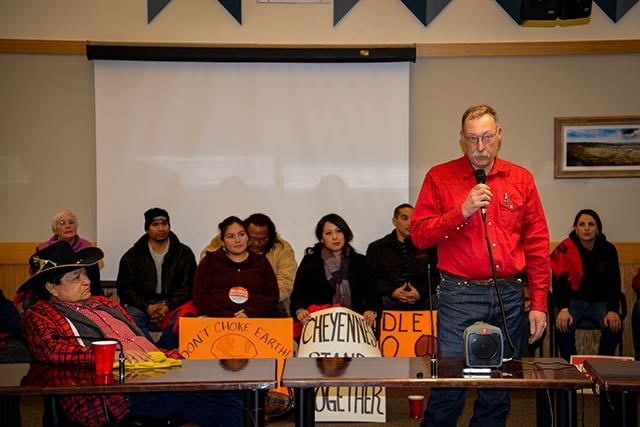 Rancher Brad Sauer testifying at the January 17, 2013, Otter Creek mine hearing in Lame Deer, Montana. (Photo by Alexis Bonogofsky)
Rancher Brad Sauer testifying at the January 17, 2013, Otter Creek mine hearing in Lame Deer, Montana. (Photo by Alexis Bonogofsky)
Keeping Montana’s Coal Reserves in the Ground
The community-based resistance to coal mining in Montana has global implications because of the recent finding that to keep the global temperature rise under 2 degrees Celsius (the point at which catastrophic climate change gains alarming momentum), the vast majority of US coal must stay in the ground.
In truth, we’re already at 0.9 degrees of warming above preindustrial averages. Limiting global warming to 2 degrees, at this point, seems slightly delusional, that is, if we wait on politicians to act. That doesn’t mean, however, we can’t prevent the most devastating impacts of catastrophic climate change. Part of keeping the global temperature rise as low as we can is keeping Montana coal in the ground.
This is what community organizing looks like. It is slow. It is long-term and it is based on respect for each other.
According to the Tongue River Railroad Company, as stated in the draft environmental impact statement (DEIS) for the railroad, “The coal resources available for transportation from the Otter Creek area will be substantial, consisting of the about 1.5 billion tons, which makes Otter Creek one of the largest undeveloped sources of low sulfur, sub-bituminous coal in the United States.” Nearly all of the Otter Creek coal is destined for coal-fired power plants and would result in emissions of approximately 2.76 billion tons of carbon dioxide.
Arch Coal executives and Montana’s politicians made many promises when the Otter Creek coal tracts were leased in 2010; the mine would be up and running by 2015. Politicians from both parties lined out in favor of the project. The Northern Cheyenne tribe was promised millions in impact funding, jobs and economic prosperity. Then billionaire Forrest Mars and Burlington Northern Santa Fe, owned by billionaire Warren Buffett, bought into the railroad. With two billionaires and the second-largest coal company in the country behind the project, it seemed inevitable.
The challenge the public is up against to keep this coal in the ground is substantial. Government agencies are not in the business of denying permits; they are in the business of issuing them. Yet, no permits have been issued to date for either the mine or the railroad thanks to the strong community coalition that has arisen to oppose both projects.
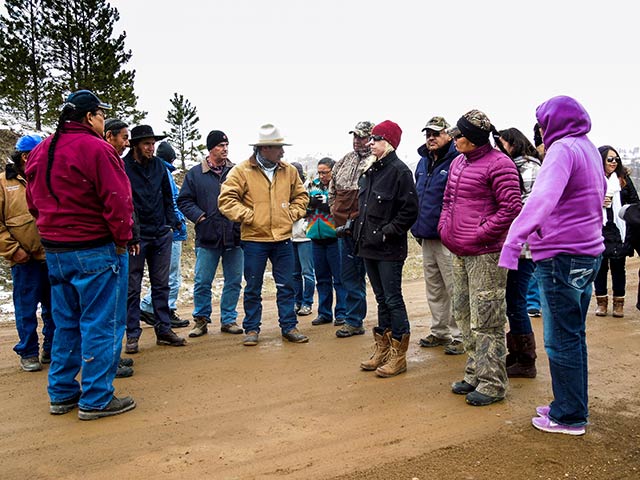 Northern Cheyenne tribal members, rancher Clint McRae, Amish community members and allies discuss the proposed Tongue River Railroad. (Photo by Beth Raboin)
Northern Cheyenne tribal members, rancher Clint McRae, Amish community members and allies discuss the proposed Tongue River Railroad. (Photo by Beth Raboin)
This Is What Community Organizing Looks Like
In the beginning, there were a number of separate communities who all, for their own reasons, wanted to stop this project. Many Northern Cheyenne feared the impacts to their water, air, cultural sites and community. The ranchers faced eminent domain, split ranches, the loss of water and the threat of wildfires from the rail line. Environmentalists feared the staggering amount of carbon that would be released when the coal was burned. Faced with an uphill battle and little political support, people got to work.
Organizers sipped coffee with conservatives who care about property rights, moved cattle with ranchers who were concerned about their water and tabled at powwows and community events to talk with their neighbors. Six years of slow and steady relationship building created a powerful bloc of community members from all different backgrounds and political persuasions, united in opposition against the mine and railroad.
In June 2015, hundreds gathered in Ashland and Lame Deer, Montana, at a public hearing held by the Surface Transportation Board concerning the draft DEIS for the Tongue River Railroad. The opposition had grown and new faces were everywhere. Regulators listened as Northern Cheyenne and their allies stood up in fierce opposition. Amish farmers whose land would also be crossed by the railroad sat quietly in the back, arms crossed on their chests.
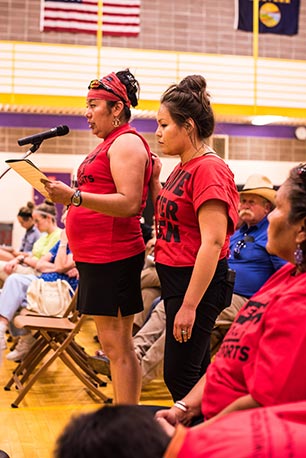 Surface Transportation Board public hearing on the proposed Tongue River Railroad in Ashland, Montana. (Photo by Alexis Bonogofsky)Northern Cheyenne tribal member Kitte Coffin summed up the testimony from the public with a simple statement: “We want the quiet, we want the peace, we want the clean air, we want the clean water and we’re not going to give it up without a fight.”
Surface Transportation Board public hearing on the proposed Tongue River Railroad in Ashland, Montana. (Photo by Alexis Bonogofsky)Northern Cheyenne tribal member Kitte Coffin summed up the testimony from the public with a simple statement: “We want the quiet, we want the peace, we want the clean air, we want the clean water and we’re not going to give it up without a fight.”
Ranchers rose to defend the cultural heritage of their Northern Cheyenne neighbors. They spoke with passion and conviction of their resolve to protect burials and ceremonial sites located on their land. Northern Cheyennes stood in defense of the property rights of the ranchers, land that 150 years ago belonged to their ancestors. Others spoke for the Amish people who, for cultural reasons, do not speak at public hearings.
After the hearing, people of very different backgrounds and cultures but with a shared love for the land gathered outside in the parking lot to share food and talk as neighbors do – about the weather, the upcoming fire season and their kids.
And then, on September 21, 2015, three days before comments on the proposed Tongue River Railroad DEIS were due, the Northern Cheyenne Tribal Council voted unanimously to oppose the Tongue River Railroad.
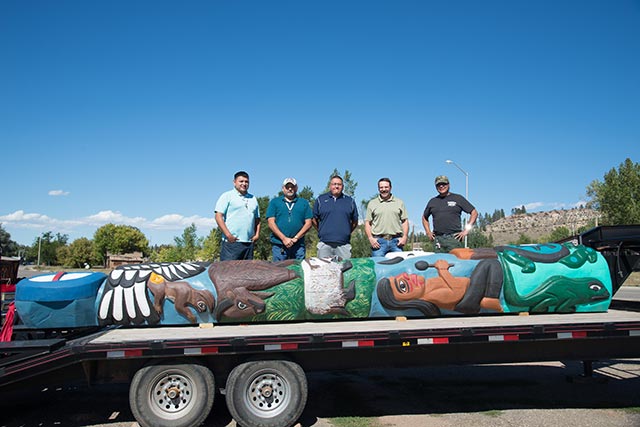 Northern Cheyenne Tribal Council members stand next to a totem pole carved for the Northern Cheyenne people by the Lummi House of Tears carvers just after the unanimous vote on the tribal resolution opposing the Tongue River Railroad. From left to right, Tribal Councilman Benjamin Headswift, Willy Rowland, Sheldon King, Tracy Robinson and ecoCheyenne cofounder Otto Braided Hair Jr. (Photo by Alexis Bonogofsky)
Northern Cheyenne Tribal Council members stand next to a totem pole carved for the Northern Cheyenne people by the Lummi House of Tears carvers just after the unanimous vote on the tribal resolution opposing the Tongue River Railroad. From left to right, Tribal Councilman Benjamin Headswift, Willy Rowland, Sheldon King, Tracy Robinson and ecoCheyenne cofounder Otto Braided Hair Jr. (Photo by Alexis Bonogofsky)
This vote didn’t just arise out of the ether, although it probably surprised many decision-makers. It was the inevitable outcome of thousands of volunteer hours that Northern Cheyennes and their allies spent organizing. Because of that, a council that had been very reluctant to take an official position on the Tongue River Railroad took action. The fight is not over but that day is getting closer.
The Tongue River Valley is now hostile territory to Arch Coal and the Tongue River Railroad Company. A large, homemade plywood “Save Otter Creek” sign sits at the main intersection of two busy highways in Lame Deer, Montana. It isn’t uncommon to pass someone in the local grocery store wearing a bright red “Save Otter Creek” T-shirt or see a car or a ranch pickup with a “Save Otter Creek” bumper sticker on the highway. As one business owner in Ashland, the closest town to the proposed mine site, recently said when asked about community support for the mine, “90 percent of the people here are against it; 10 percent of the people are violently against it.”
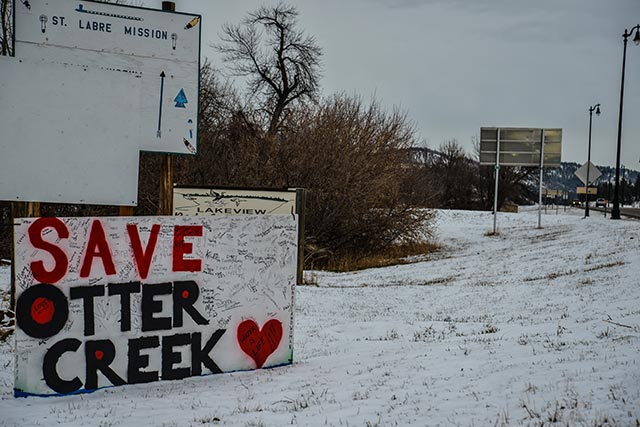 A “Save Otter Creek” sign placed at the main intersection in Lame Deer, Montana, on the Northern Cheyenne Reservation. (Photo by Alexis Bonogofsky)
A “Save Otter Creek” sign placed at the main intersection in Lame Deer, Montana, on the Northern Cheyenne Reservation. (Photo by Alexis Bonogofsky)
Through constant watchfulness of every government action and high levels of public participation in every decision, the timeline on the mine and railroad when from imminent to indefinitely delayed. This is what community organizing looks like. It is slow. It is long-term and it is based on respect for each other. The key word is “community.” In this case, small groups that had little power alone united and now are joining with those fighting the coal ports in the Northwest. People are finding common ground while they move forward together. They are winning and protecting their special places and the climate at the same time. These connections will last long after the Otter Creek coal mine and Tongue River Railroad have become just words on a piece of paper in a government office.
Media that fights fascism
Truthout is funded almost entirely by readers — that’s why we can speak truth to power and cut against the mainstream narrative. But independent journalists at Truthout face mounting political repression under Trump.
We rely on your support to survive McCarthyist censorship. Please make a tax-deductible one-time or monthly donation.